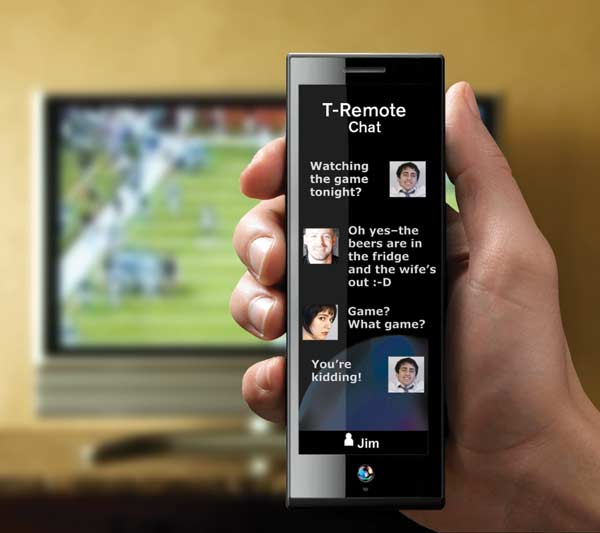Social TV

The viewership for live television broadcasts has generally been declining for years. But something surprising is happening: events such as the winter Olympics and the Grammys are drawing more viewers and more buzz. The rebound is happening at least in part because of new viewing habits: while people watch, they are using smart phones or laptops to swap texts, tweets, and status updates about celebrities, characters, and even commercials.
Marie-José Montpetit, an invited scientist at MIT’s Research Lab for Electronics, has been working for several years on social TV–a way to seamlessly combine the social networks that are boosting TV ratings with the more passive experience of traditional TV viewing. Her goal is to make watching television something that viewers in different places can share and discuss–and to make it easier to find something to watch.
Carriers, networks, and content producers hope that making it easier for viewers to link up with friends will help them hold on to their audiences rather than losing them to services like Hulu, which stream shows over the Internet. And opening TV to social networking could make it easier for companies to provide personalized programming.
Many developers are working on ways to let people share the viewing experience over broadband connections or through set-top boxes; indeed, cable companies and other broadband video providers have sponsored small trials of various interactive TV services around the world for more than 20 years. But most of the systems were even clumsier than the combination of laptop and large-screen TV that today’s viewers have kludged together. Montpetit wants to unite different communication systems–especially cellular and broadband services–to create an elegant user experience. She’s been sharing ideas about that sort of system with BT, which provides broadband connections to 15 million people in the United Kingdom and Ireland, including nearly a half-million digital-TV subscribers.
Though BT won’t comment on what form its social-TV system might take, Montpetit and her students at the MIT Media Lab demonstrated an intriguing prototype last year. A central database aggregates video from online sources like YouTube, shares user-specified data with social networks, delivers video to the user’s TV, and lets users and the people in their networks send comments and ratings back and forth via an iPhone app. It avoids using the TV screen for messages, something that has proved irritating to consumers who don’t want clunky text obscuring the pictures on their 52-inch HDTVs. The app also allows the user to tell the network what program to show on his or her set. For instance, if a friend suggests a show and the owner agrees, that show will pop up at the appointed time. In February, Montpetit and her students presented a refined version of this system to BT. Jeff Patmore, who works with Montpetit as head of strategic university research at BT, says such a system could be rolled out this year, although he declines to confirm any plans. But Montpetit anxiously awaits U.S. deployment of social TV: her daughter, with whom she watches certain shows, heads off to college next fall. Engineering and business issues aside, she wants social TV to help friends and family stay connected, even as they move apart.
Keep Reading
Most Popular
Large language models can do jaw-dropping things. But nobody knows exactly why.
And that's a problem. Figuring it out is one of the biggest scientific puzzles of our time and a crucial step towards controlling more powerful future models.
The problem with plug-in hybrids? Their drivers.
Plug-in hybrids are often sold as a transition to EVs, but new data from Europe shows we’re still underestimating the emissions they produce.
Google DeepMind’s new generative model makes Super Mario–like games from scratch
Genie learns how to control games by watching hours and hours of video. It could help train next-gen robots too.
How scientists traced a mysterious covid case back to six toilets
When wastewater surveillance turns into a hunt for a single infected individual, the ethics get tricky.
Stay connected
Get the latest updates from
MIT Technology Review
Discover special offers, top stories, upcoming events, and more.